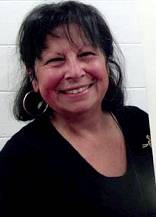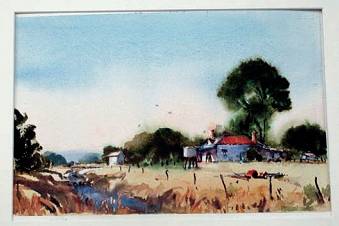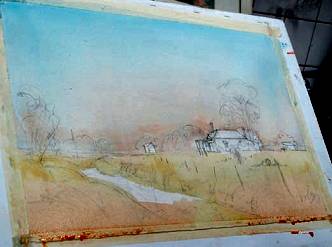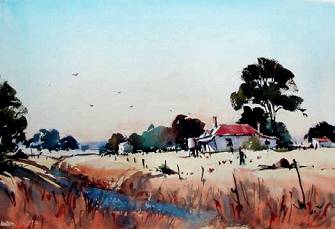Annee Kelly Demonstration 21st June 2014
Watercolour Landscape
 Annee
was a pleasant, modest but confident watercolour artist. She was born in
Alexandria, Egypt, a very cosmopolitan city. She went to a French school
and speaks French fluently, which is a great asset when she takes art
tours to Europe. This year she is going to south-west France, Bordeaux,
Rocamadour, Sarlat etc. Next year she will take a group to Italy. These
tours sound fascinating. There are still places available so contact her
if you are interested, on
annee@annee_kelly.com.au
Annee
was a pleasant, modest but confident watercolour artist. She was born in
Alexandria, Egypt, a very cosmopolitan city. She went to a French school
and speaks French fluently, which is a great asset when she takes art
tours to Europe. This year she is going to south-west France, Bordeaux,
Rocamadour, Sarlat etc. Next year she will take a group to Italy. These
tours sound fascinating. There are still places available so contact her
if you are interested, on
annee@annee_kelly.com.au
As a child she was very much into art but there was little future in that
in Egypt. Her family came to Australia where she took teacher training and
worked for years as a secondary language teacher. With her children grown
up she turned to fulltime painting. Her influences were Ron Muller, Robert
Wade, David Taylor, Alvaro Castagnet, Joseph Zbukvic - you can see how
fortunate she was to lob in Melbourne with all those great watercolourists
on hand.
Discussing her work ideals, she emphasized composition and design and
illustrated them by referring to her works which she had on display.
Points of interest should be off-centre rather than symmetrical. Balance
one thing with something different. If a colour appears here repeat it in
other parts of the picture.
Her nice new palette was loaded with Daniel Smith paints. American and
expensive, but she had recently won a $1000 prize so she had spoiled
herself. She mixes her own greens, apart from an olive green which she
loves. You can mix most colours using just red, yellow and blue. Rembrandt
is another good brand, she said.
Brushes need not be expensive as long as they make a good point. She
hardly used more than one pointy one and one broad wash brush all day.
 Her
work is mainly done outdoors but you don’t just sit anywhere and start.
Plan first by choosing, composing in your mind and making a few black and
white tonal sketches. Then evaluate them before committing yourself. She
gave us a great quote from Robert Wade: “Failing to prepare is preparing
to fail.” In preparing she had done the tonal sketches, made a mini
version of the picture in colour and made a light pencil sketch on the
full size board.
Her
work is mainly done outdoors but you don’t just sit anywhere and start.
Plan first by choosing, composing in your mind and making a few black and
white tonal sketches. Then evaluate them before committing yourself. She
gave us a great quote from Robert Wade: “Failing to prepare is preparing
to fail.” In preparing she had done the tonal sketches, made a mini
version of the picture in colour and made a light pencil sketch on the
full size board.
To start with the sky she inverted the board, wet the area and swept
yellow across in a few broad strokes. While it was still wet blue was
added to half of the sky. The risk here is that it will go green so don’t
go back into it. She manipulated the board to allow colours to run.
 The
yellow area of the mid ground cornfield came next, cutting around the
farmhouse and sheds. But not around the trees, you can put them in over
the sky and fields when dry. She monitors the wetness/dryness of the paper
to decide what she is able to do in different parts of the picture.
The
yellow area of the mid ground cornfield came next, cutting around the
farmhouse and sheds. But not around the trees, you can put them in over
the sky and fields when dry. She monitors the wetness/dryness of the paper
to decide what she is able to do in different parts of the picture.
A little break for talk and she can now add trees, quite dark. They will
dry lighter. She scumbles the foliage with the brush on the side. The
house roof red, the shadows on the walls mauve, the tank a bit rusty.
Conserve some whites to give it sparkle. If areas are a bit flat she drops
a bit of opposite colour into the damp. It was quite colourful. She tossed
in some typical farm junk around the yard. By now the detailed farmhouse
made the foreground look pale and empty. Time to work on that. She had
used masking fluid on a few bits, so that came off with a rub. It leaves a
hard edge which she did not want, so she softened the edges with a bristle
brush in clean water.
 Then
she went into the foreground with orange/brown, dancing the brush over it.
There was an area of water which has to reflect the sky colour. She did it
a stronger blue as it would dry lighter. What next to finish up? Fence
posts, a farmer, some chooks and birds. Stop before you stuff it up. Place
a mount around it. Great. Loud applause. The big audience appreciated a
great demonstration.
Then
she went into the foreground with orange/brown, dancing the brush over it.
There was an area of water which has to reflect the sky colour. She did it
a stronger blue as it would dry lighter. What next to finish up? Fence
posts, a farmer, some chooks and birds. Stop before you stuff it up. Place
a mount around it. Great. Loud applause. The big audience appreciated a
great demonstration.
Colin Browne, WAA Secretary